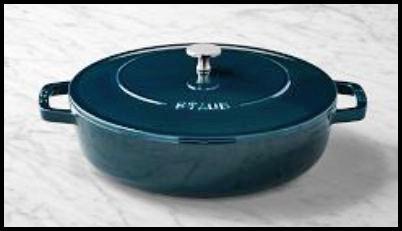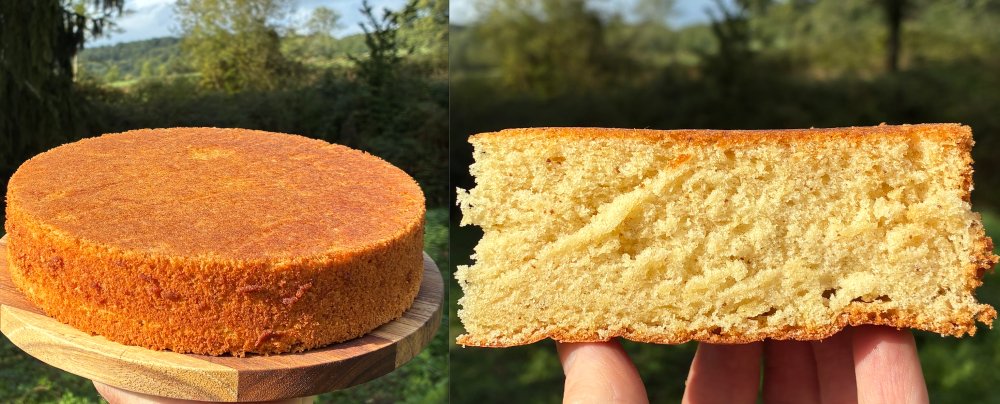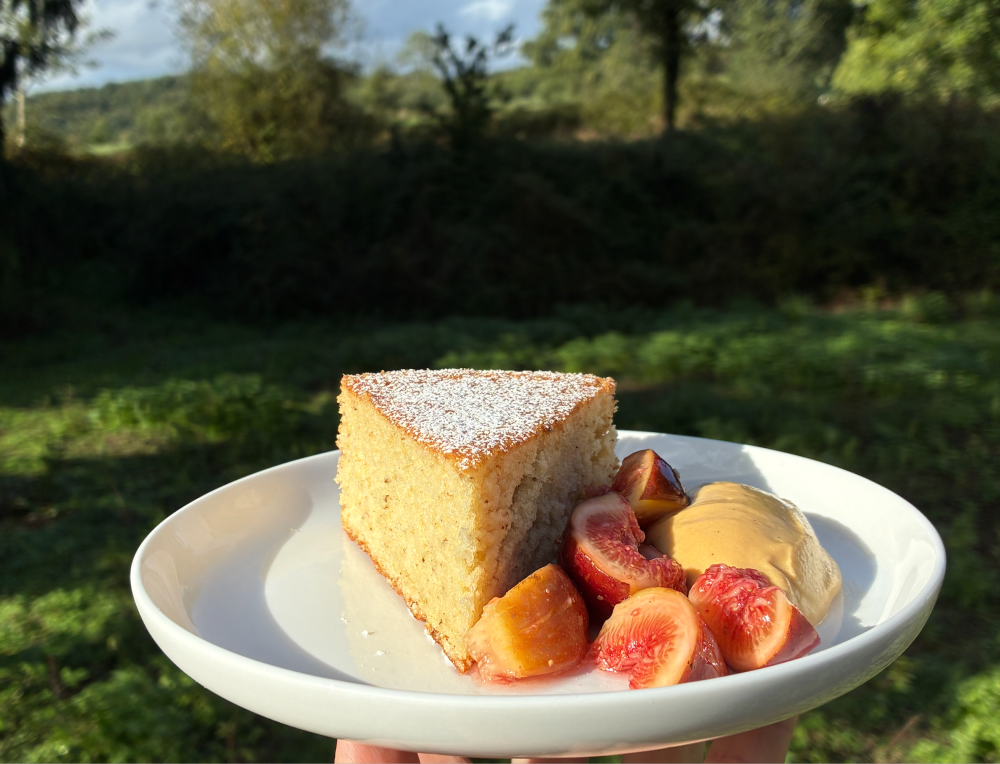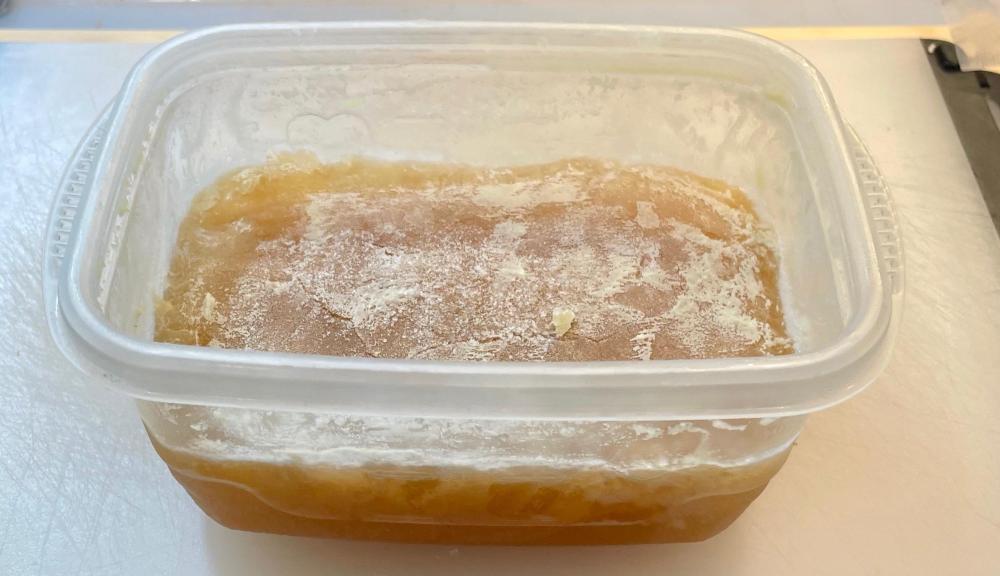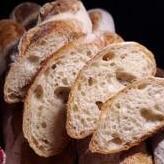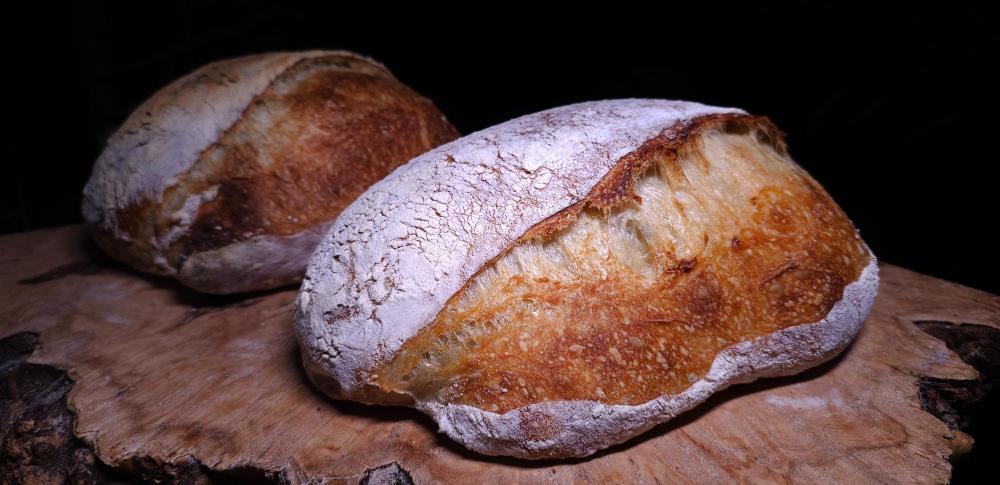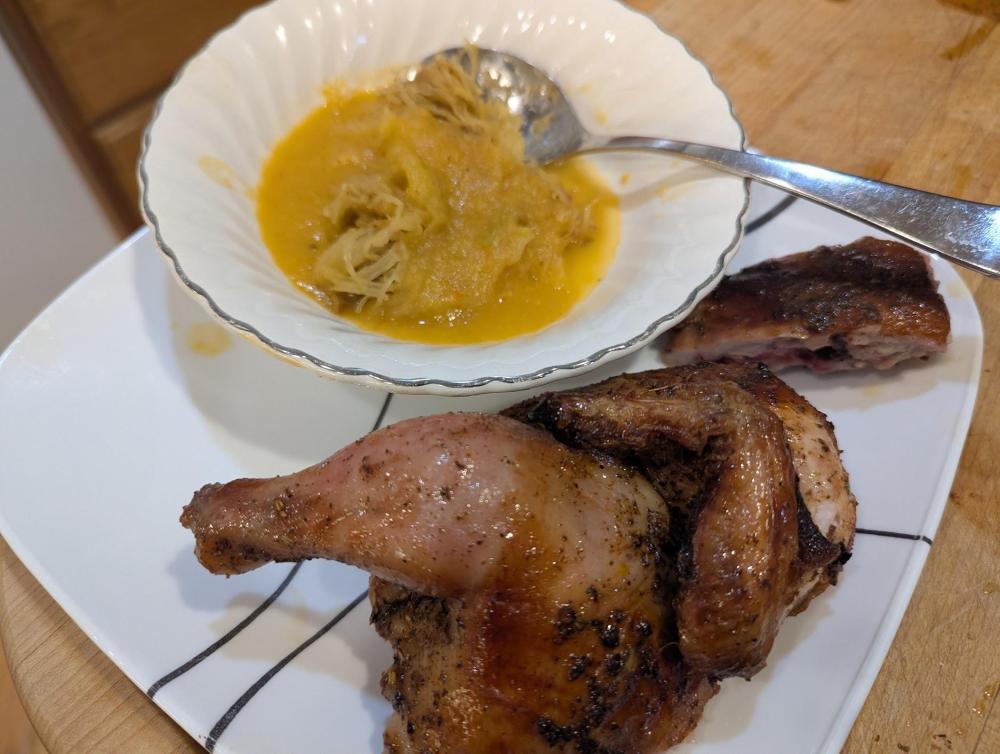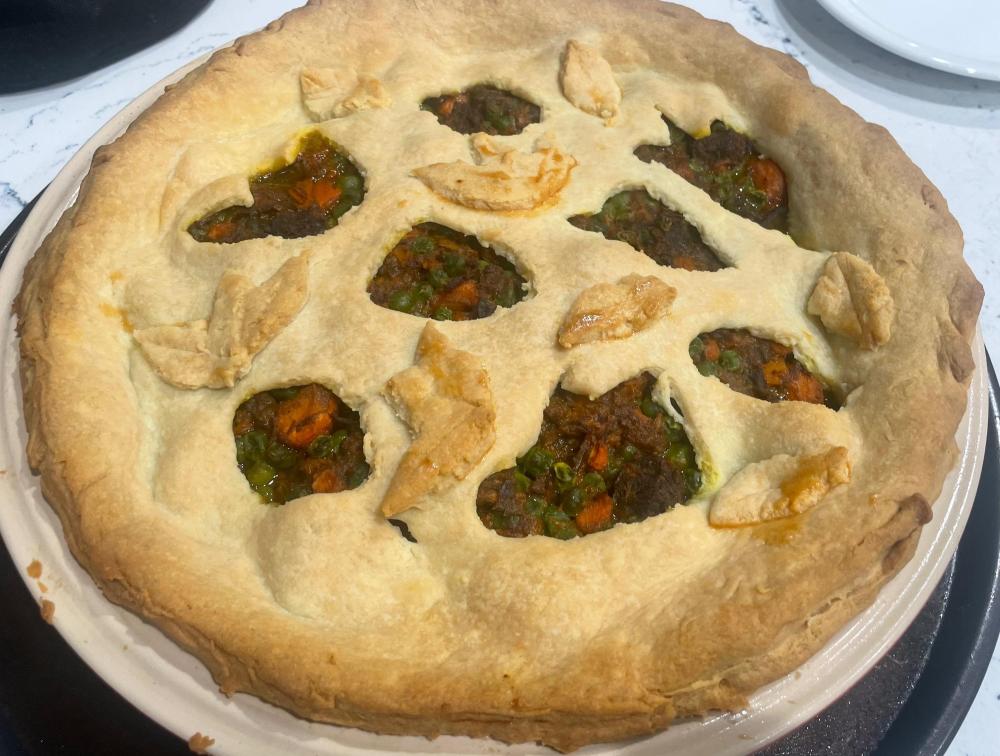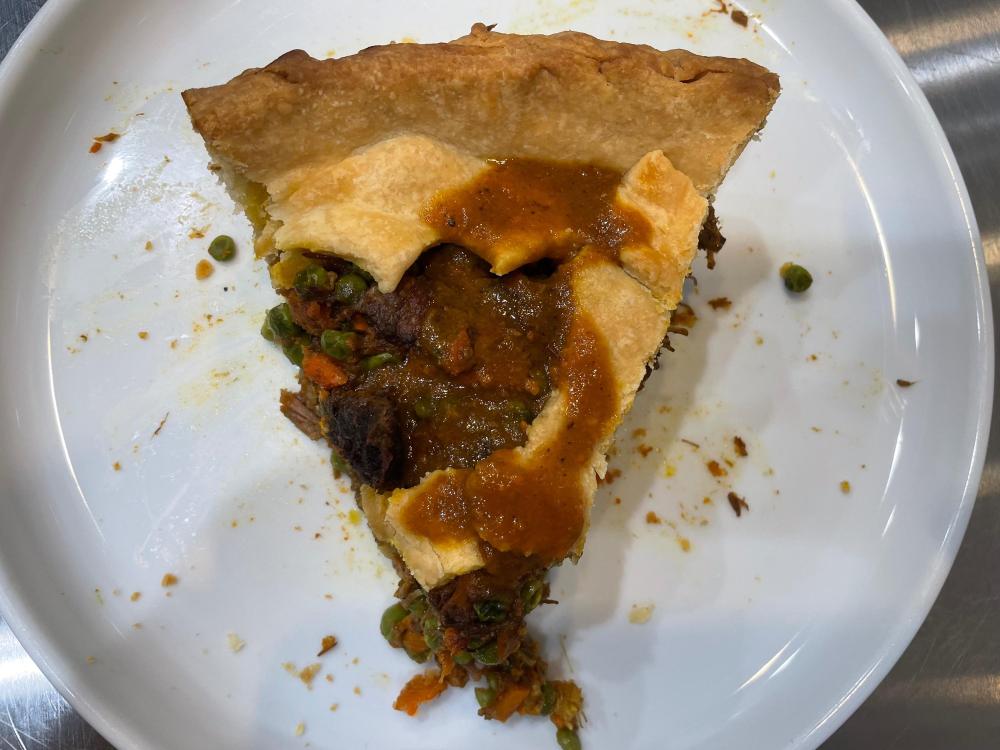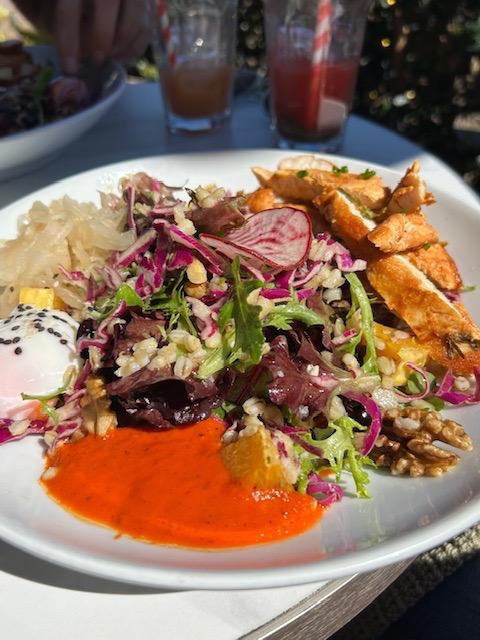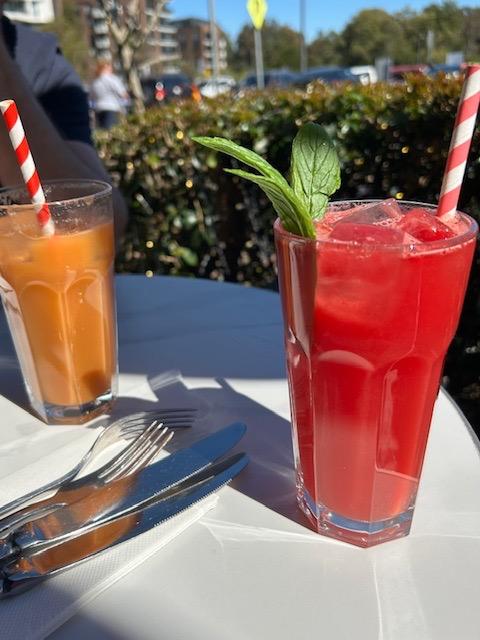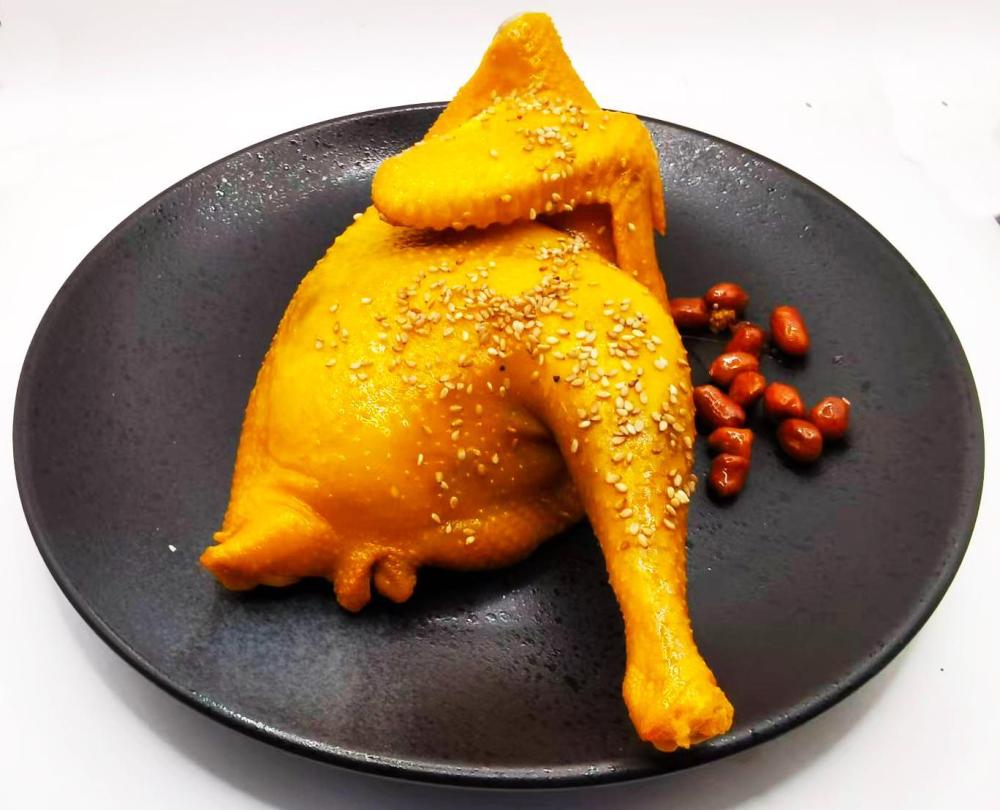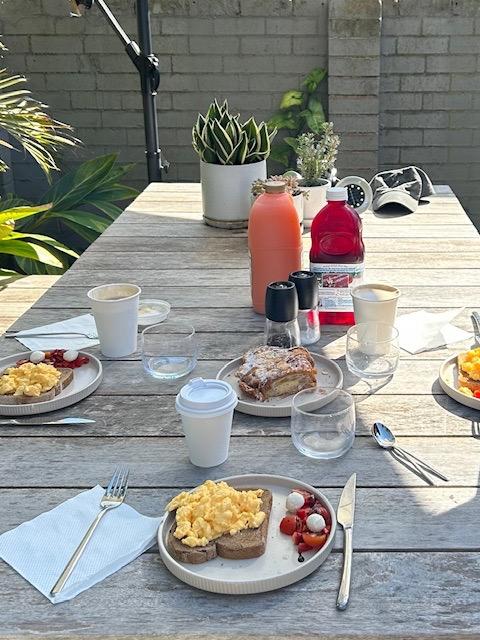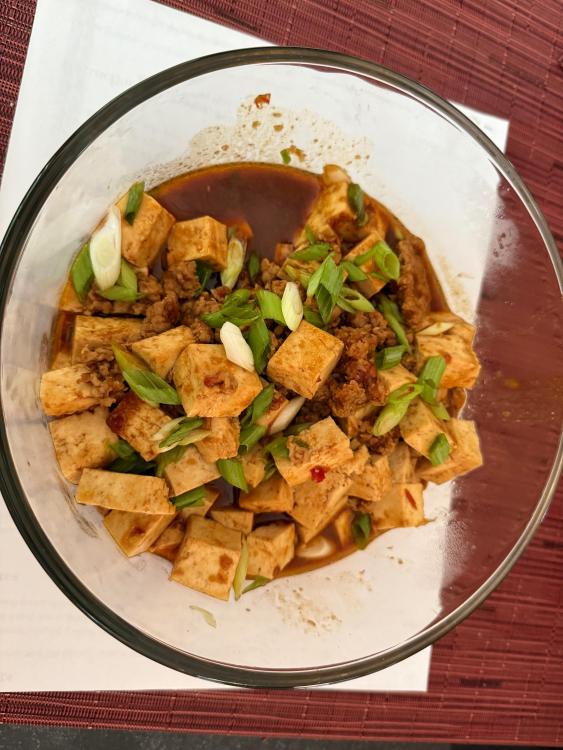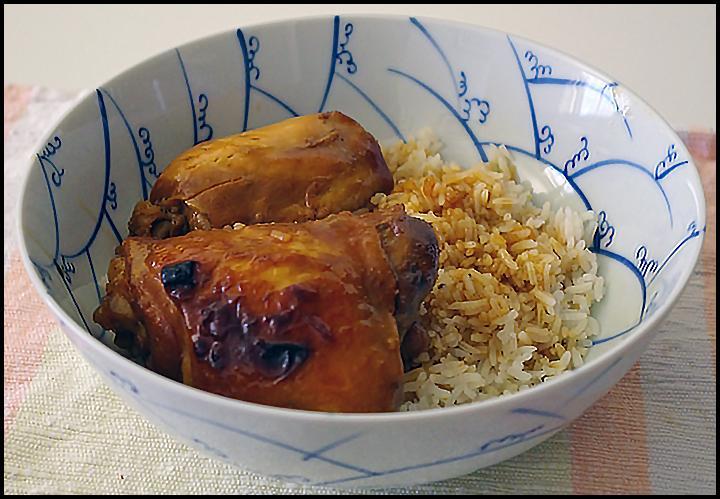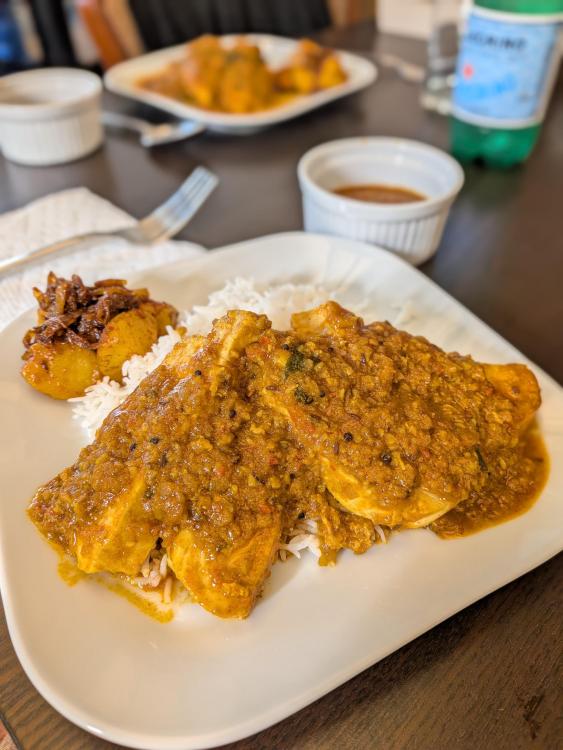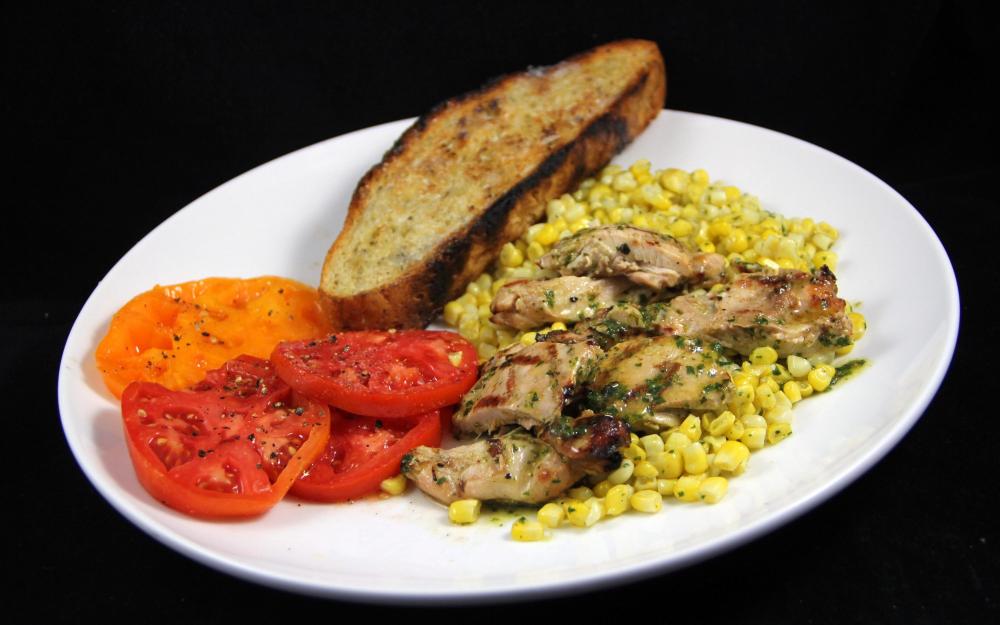-
Welcome to the eG Forums, a service of the eGullet Society for Culinary Arts & Letters. The Society is a 501(c)3 not-for-profit organization dedicated to the advancement of the culinary arts. These advertising-free forums are provided free of charge through donations from Society members. Anyone may read the forums, but to post you must create a free account.
All Activity
- Today
-
I miss oxtail. The stores around here have taken to selling one "knuckle" surrounded by ~2 inches of fat for some extraordinary price per pound. If one cut off all the fat, the meat would weigh half as much. Makes me so mad I refused to buy any. Last Saturday was the farmers' market and a farmer listed oxtail on their offerings. I picked up the oxtail and peeled off a little of the covering paper so I could see the meat, i.e. how much fat was on the meat. The farmer was offended that I was tearing the paper covering, and the bones looked primarily covered in meat (not fat) so I bought two of them wieghing about 2.4 lbs each. It was frozen, so it's been sitting in the fridge. I just went to put the pieces in a sous vide bag, but the "knuckles" are not cut apart. I've spent 20 minutes at it with only ONE successful cut. How do I find where to separate all the pieces of tail bone? P.S. If I can't figure out how to separate the "knuckle" bones, can I sous vide cook 12" parts of the tail in a large plastic bag, then separate them when they're cooked?
-
I think @rotuts point is rather to make full use of the vast information provided in this forum by using the search function …
-
Well, Mr. Rotuts, thanks for that reminder. My memory can be poor at times, and it's certainly spotty. Nice to know that I was correct about reading the info in Molly Stevens' book. In any case, I appreciate your taking the time to check up on my contributions and posting history. Keep up the diligence, and feel free (I think you already do) to remind me of my errors, omissions, and carelessness. It's nice to know that you're there as a good backup for my poor memory.
-
Asked by this same OP , June 2024 ? https://forums.egullet.org/topic/143759-braising-help-needed/page/3/ and answered ?
-
There is an in-depth discussion on browning in various braising vessel here: The truth about braising: assignment 1 The truth about braising: discussion 1 As well as the braising step itself: The truth about braising: assignment 2 The truth about braising: discussion 2 Part 3 & 4 are also worth a read …
-
What benefit, if any, can be had from using a "dedicated" braisier, like the style shown below, over a Dutch oven, sauté pan, or other style pot. I vaguely recall Molly Stevens commenting on this in her book, All About Braising, but the book is not here now, so what do the braising gurus say?
-
Your Daily Sweets: What Are You Making and Baking? (2017 – )
Pete Fred replied to a topic in Pastry & Baking
Another addition to my unending list of plain brown cakes: Rose Levy Beranbaum's Whipped Cream Cake (YouTube)... This is the third WCC I've tried, after Richard Sax and King Arthur. They all have slightly different methods, and the RLB has about 1.5x the cream. I'm a fan of WCC, and this was pleasant, but the Sax one is the best of the bunch. I had it with some figs, and caramelised apple purée whipped into strained fromage blanc... -
@ElsieD Stop&Shop doesn't usuallt have very good sales , compared to Marketbasket. however , they periodically have very good deals on CkDrums , and even wings . I dont cook wings wings go on sale @ $ 2.48 . the store brand chicken @ stop&shop is significantly larger , thus more meat // bone , and better presented than MB . and in the past , S&S has had Fz turkey ( whole ) breasts for $ 0.99 , same turkey ( StoneyBrookFarm ) never goes below $ 1.29 / lbs at MB. go figure.
-
I just checked the "specials" for chicken drumsticks prices this week. They range from $3.00 to $4.99 a pound.
-
The Bhuna Thread. So, what is a Bhuna? Here in the U.K. today a Bhuna is usually a British Indian Restaurant (BIR) style curry, thick, flavourful and served in a rich, but plentiful sauce. Prepared by frying spices with meat and simmering it in its own juices, the end result is commonly distinguished by the addition of onions and green peppers. Back in London in the seventies and eighties, when my love of Indian food was in its formative years, the dish would have appeared on the menu of many “Curry Houses” as “Dry”, or “Medium, thick”. Medium, referred to its heat level and thick, the consistency of its sauce. The change in the restaurant dish over 40-50 years is quite noticeable and if the two were served side by side, either then or now, the diner may struggle to identify them as the same dish. For me a Bhuna is defined by a thick and intense dry sauce, as opposed to a dish swimming in a significant amount of liquid. Characterised by deeply browned onions, the sauce achieves its full flavour as a result of a long slow simmer in the juices of the principal ingredient balanced with the judicious use of herbs, spices and aromatics. In her Ultimate Curry Bible, Madhur Jaffrey explains that Bhuna dishes were a fairly common meal when growing up at home, she goes on to describe them as the “First Cousins” to Kebabs, being cooked until they are practically dry and then being served with bread; a sliced onion relish being the perfect accompaniment to roll up with the meat. In his informative and indispensable Indian Cookery, first published in 1970, Dharamjit Singh offers “frying” as the alternative English word for Bhoona (his spelling), he further explains there are three distinct styles of Bhoona. SUKHA BHOONA is a simple sauté, using thinnish fillets of best quality meat, lightly seasoned with pepper and salt, and may possibly have green herbs crushed to a paste and rubbed into the meat. DUMNED BHOONA is a pot roast. The meat first marinated or rubbed with aromatics, then seared, moistened and cooked in a tightly closed vessel, either in the oven or over charcoal with more charcoal placed on the lid. ARD BHOONA is a dry pot roast employing butter only, and no liquid or marinade. The meat is first seared, then placed in a heavy casserole and drenched in butter. The lid is closed tightly and cooking completed in the oven. More butter is added during cooking. The Ard Bhoona is reportedly best with white meat. The simple sauté that is Sukha Bhoona traditionally uses very small pieces of meat or vegetable cooked in a minimum of very hot fat, it should be capable of instantly searing the surface. The food must be cooked quickly and kept moving all the time, though this seems contrary to Singh’s assertion that “some of the flavour of the Sukha Bhoona comes from allowing the meat to stick just a little to the bottom of the pan and scraping up the residue with a spatula”. White meats should be covered after the initial searing on both sides, and will be cooked in a few minutes. In the Dumned Bhoona (steamed-fried), water or akni is added to the casserole with the seared meat, and in sufficient quantities to leave a generous amount of gravy. The meat is usually in one large piece (two to five pounds in weight) and must be boned, with all fat removed. Cook in a medium oven, and shake the casserole from time to time so that the top of the meat is basted. When tender leave uncovered in a low oven for a few minutes before serving. Use your heaviest casserole for the Ard Bhoona; it must have a tight fitting lid that can be well sealed. Lay a bed of aromatics and any vegetables specified in the recipe. Add the seared meat, drench with clarified butter and seal the casserole. Place in a very hot oven and reduce heat to low after ten minutes. Add more butter when the first has dried, shake the casserole and return to the oven. Repeat, if necessary, until tender. Meat may be cooked whole, or cut into smaller pieces. Take care that the vegetables are not cut up so small that they become overcooked. There are probably as many Bhuna recipes as there are people cooking it, each persons having a personal preference for “a pinch more of this” or a “dash more of that”. But it is a cooking method rather than a dish, and whilst the individual recipes can vary greatly depending on the cook, there are basic spices and herbs that are common constituents to most recipes. These being, Ground coriander Ground cumin Ground turmeric Curry powders and blends Mustard seeds Fennel seeds Paprika Chilli powder Garam masala Black pepper Dried, crushed fenugreek leaves (kasoori methi) For the aromatics, garlic, ginger and shallots or onions are essential ingredients without compromise! Whilst the predominant meat used in a bhuna on the subcontinent is goat or mutton, in the west lamb, chicken, beef, fish or prawns are often substituted. What vegetables you choose to accompany the main ingredient is your choice – commonly used are peppers, cauliflower, carrots, green beans, potatoes and tomatoes or, in my house, spinach. For the initial searing of the meat, ghee is my preferred fat as I prefer the taste and it can withstand high temperatures, but different areas employ different fats that bring their own regional flavours to the finished product. The next additions to the pot will be ginger, garlic and onions, or shallots, fried off over a low to medium heat until they are browned. The occasional splash of water to the mixture prevents it from drying out and burning. A particular trick I learned from a Parsi friend, which he advised is common in their cooking, is the addition of a large splash of water into the hot fat frying the onions, cover the pan for a few minutes to allow them to soften in the resultant steam before uncovering and cooking off all the excess water, then allowing the caramelisation to continue. This can significantly reduce the time it takes to achieve those browned onions. Once the onion mixture is suitably caramelised fry off any dry spices with a further splash of water to stop them burning, or make a paste of them beforehand. Long, slow cooking of the meat with the masala paste and aromatics results in a flavoursome and spicy sauce, but ultimately the most important technique is slow folding of the meat and vegetables over a high heat until all the excess moisture has evaporated. This really intensifies the flavours and produces the merest hint of a clingingly thick sauce. Remember that a bhuna should never be runny. If a curry with plenty of gravy is your preference you need to look outside of a bhuna. Garnish the finished dish with fried onions, fried green bell peppers and a generous sprinkling of chopped, fresh, green coriander and serve it with rice or naan and a selection of Indian pickles and side dishes. In a U.K. BIR you will undoubtedly see Bhuna listed on the menu under the “Traditional” heading alongside the likes of Korma, Jhalfrezi, Madras and Biryani amongst others. It will be made from a base gravy, that is a constituent part of most of the dishes served in such establishments, with a standardised mixture of spices and garnishes. Any meat in the dish will have been pre-cooked to allow for a prompt turnaround in the orders. What it won’t offer you are the regional specialities cooked in the Bhuna style that are found across India and its near neighbours. These offer local ingredients in a myriad of taste sensations that, flavour-wise, are far removed from each other with only the cooking process in common. So here are a few traditional Bhuna style dishes from different areas to showcase the diversity of this particular method of preparation. The Rara is a good example of a regional speciality cooked Bhuna style. Mutton Rara Mutton Rara or Rara Gosht is of Punjabi origin, unusually combining both cubed mutton and minced mutton (keema). The key to the successful preparation of the Rara is the patience shown in executing the Bhuna process, for which the time and effort will result in a great tasting dish. Ingredients: 500g cubed mutton 200g minced mutton 125g thick yoghurt, beaten 1 teaspoon salt 125g ghee 3 – 4 medium onions, cut in half lengthwise and sliced into half-moons 2 tablespoons ginger garlic paste 1 Tablespoon green chilli paste (more or less dependant on your penchant for heat) 1 teaspoon red Kashmiri chilli powder 1 teaspoon garam masala 1 1/2 tablespoons ground coriander 1/4 teaspoon turmeric 1 tsp ground cumin 2 green chillies, slit lengthwise 1 tsp crushed dried fenugreek leaves Salt and freshly ground black pepper to taste Whole Spices 3 – 4 cloves 4 green cardamom 2 brown cardamom 1 ” cinnamon stick 1 Indian bay leaf (Tej Patta) For Garnish A small handful of chopped green coriander a 2-inch piece of fresh ginger, peeled and julienned Method: In a bowl mix the mutton pieces with the yoghurt and salt and set aside to marinate for 3 to 4 hours or, preferably, overnight. Mix together all the dry ground spices, red chilli, garam masala, coriander, turmeric and cumin with enough water to make a paste. Heat the ghee in a heavy bottom pan, once hot add all the whole spices and fry for 30 seconds. Add in the chopped onions and fry until they are caramelised and reach a nice dark brown colour; be careful not to burn them. Add the ginger garlic and chilli pastes and continue to cook until the raw smell disappears. Add the spice paste (masala) you made earlier, adding further water if needed to ensure it doesn’t burn. Once any moisture has evaporated, add the mince and Bhuna (fry) it for 10 minutes until it loses its pink colour, breaking up any large lumps. Add the marinated mutton pieces with the yoghurt marinade and continue the Bhuna process, stirring the mutton until it loses its raw colour. Cover and allow it to simmer on a gentle heat in a mixture of its own juices and the yoghurt marinade until it is tender. Once tender turn up the heat and slowly stir and fold until a thick dark brown gravy is reached. As you Bhuna the meat it will gradually become darker as it thickens. Finish with the addition of the split green chillies and crushed methi then cook for a further 5 minutes. Test for seasoning then serve the mutton in a bowl garnished with chopped green coriander and ginger juliennes. Serve with naan, tandoori roti or phulka. Another version of a Bhuna but one with a distinctly regional spice variation is the legendary West Bengali dish, Kosha Mangsho. Mangsho translates to meat and Kosha means to sauté or cook for a long time. This long slow process both tenderises the mutton and greatly intensifies the flavours which are enhanced and enriched when the pan juices are further reduced to a thick gravy that coats the meat. An authentic and traditional version of this recipe can often include the spice, radhuni (Trachyspermum Roxburghianum).This wild celery flavoured spice, also known as ajmod in Hindi, is often confused with ajwain or carom seeds. It can be incorporated into the Kosha Mangsho in a number of ways. It can be individually bloomed in the hot oil, ground and used in a mixed masala or incorporated into the Bengali spice mix, Panch Phoran. Panch Phoran literally translates to “five spices” and is a mixture of five whole spices which, in the west, usually consists of fenugreek, nigella, cumin and fennel seeds accompanied by mustard seeds. The more traditional mixes omit either the mustard or nigella seeds and replaces them with radhuni seeds. I have also seen references to radhuni as the “sixth” seed which somewhat contradicts the name “five spices”. Most of the recipes you will see for Kosha Mangsho will not include radhuni. This makes the dish more accessible here in the UK as the spice is not readily available. I have personally trawled through the Bangladeshi areas of London in search of the spice, and though the shop keepers are aware of its existence, none of them I visited have stocked it or could obtain it through their wholesalers. The only availability seems to be online at an extremely inflated cost with delivery charges on top. Where are my Bangladeshi friends when I need them? The use of mustard oil, sugar and radhuni in this recipe are representative of many Bangladeshi curries, what differentiates this Kosha Mangsho from so many others is the lack of potatoes which are nearly always present. Kosha Mangsho Ingredients: Marinade: 1 kg mutton, bone in, cut into 2-inch chunks 125g plain yoghurt 2 tbsp mustard oil 1 tbsp ginger paste 1 tbsp garlic paste 1 tsp turmeric powder 1 tsp red chilli powder 1/2 tsp ground radhuni 1 tsp salt Masala: 125ml mustard oil 1 stick cinnamon 4 green cardamom pods 4 cloves 2 bay leaves 1 tsp sugar 3 large onions, thinly sliced 1 tbsp ginger paste 1 tbsp garlic paste 1 tsp cumin powder 1 tsp coriander powder 1 tsp Kashmiri red chilli powder To finish: 1 tsp garam masala powder 1/2 tsp ground radhuni 1 tbsp ghee Fresh coriander leaves, chopped Method: In a bowl combine the yoghurt and mustard oil, add all the whole and ground marinade spices and salt then mix well. Add the mutton and stir to ensure all the meat is coated then cover the bowl and refrigerate for at least 2 to 3 hours but preferably overnight. In a heavy-bottomed pan, heat the oil until wisps of delicate, white smoke waft up from the pan and the aroma begins to fill your kitchen. Remove from the heat and allow it to cool it to the cooking temperature. Return to the heat then add all the whole spices, cinnamon stick, cardamom pods, cloves and bay leaves; fry for 30 seconds. Add in the chopped onions with the sugar and fry until caramelised and they reach a nice dark brown colour, be careful not to burn them. Add the ginger and garlic pastes and cook for two to three minutes, add the dry spices, cumin, coriander and Kashmiri red chilli powder with a splash of water and continue to cook, stirring, until the raw smell disappears and the oil starts to separate from the masala. Add the mutton along with its marinade and continue the bhuna process, stirring the mutton until it loses its raw colour. Cover and allow it to simmer on a gentle heat, checking and stirring for 90-120 minutes or until the mutton is tender. Once tender increase the heat and "koshano" (fry) the meat until the sauce has reduced and darkened and is left coating the mutton. To finish off the dish, stir in the garam masala and the remaining 1/2 teaspoon of ground radhuni for a final aromatic boost. Stir in the ghee, then turn off the heat. Sprinkle on the fresh chopped coriander leaves and serve hot with steamed rice or breads. Chicken Bhuna is thought to have originated in the Bengal region of India where the term 'bhunna' is Urdu for 'fried'. The “bhunna” typically consists of a base of onions, garlic, ginger and spices being fried together to form a thick coating sauce. Chicken Bhuna This Chicken Bhuna, made with potatoes and tomatoes is an authentic Bengali recipe that will please chicken lovers. Despite the inclusion of potatoes it would not be unusual to see this served with rice or chapati. Ingredients 500g boneless, skinless, chicken thighs, cut into bite sized pieces 4 large cloves of garlic, roughly chopped 2” piece of root ginger, peeled and roughly chopped 6 green chillies, roughly sliced 4 green cardamom 1 cinnamon stick, broken 4 cloves 90ml vegetable oil 2 medium potato’s cut into 5cm cubes 1 teaspoon sugar 2 Indian bay leaves (tej patta) 2 medium onions, evenly sliced into half moons 1 tomato roughly chopped 1/2 teaspoon salt, or to taste 1/2 teaspoon ground turmeric 1 teaspoon powdered red chill 3 tablespoon water Method Add garlic, ginger and chillies with 1-2 tablespoons water to a food processor and blitz to a paste. Transfer to a small bowl. Now, place a dry pan over medium heat, add green cardamom, cinnamon stick and cloves. Gently dry roast these whole spices until you can smell their aroma. Allow to cool and transfer to a spice grinder or pestle and mortar and grind to make a coarse powder. Set this freshly made garam masala to one side. Place a deep-bottomed pan over medium high heat and when hot add half the oil. Add the chopped potatoes and fry these until they are golden-brown in colour then transfer them into a bowl. Heat the remaining oil in the same pan and once hot add sugar and allow it caramelise, stirring and shaking to stop it from burning. Add bay leaves and sauté them until aromatic. Place the sliced onions in the pan and cook until they turn medium brown in colour. Now, add the chicken pieces to the onions and fry them until they lose their raw colour. Add the garlic, ginger, chilli paste, chopped tomato and salt and mix well. Cook until tomatoes become tender and start to break down and thee raw smell from the aromatics has been cooked out. Reduce the heat to low, add ground turmeric and chilli powders with the water, mixing it well to evenly coat the chicken. Bring to a simmer. Let the chicken cook for 10 minutes then return the fried potatoes to the pan, toss to coat them, then sprinkle with the freshly made garam masala and stir to mix it well. Cover and cook for another 20 minutes until the chicken is cooked through and the potatoes are tender. Test for seasoning and adjust to taste. As soon as the oil separates, take it off the heat and transfer to a bowl. Serve it with rice or chapati and some Indian vegetables.
-
- 4
-

-

-
@ElsieD this was two trays of CkDrums. price went up 10 cents from previous sale ! ( 11.1 % ) so that's from 18 legs . I saved one for MC . he sometimes get some of the ' shreds ' , I dont press too hard on one container for him. I ran the CkDrums through the iPot 3 times , so 3 X stock . no seasonings used for that reason . seasons up when i sue the, I open a Fz brick , use a cleaver and whack what I plan to use , and get the same brick back into the same bag quickly , and re-vac . then back to the freezer. even Fz it has a wonderful chicken aroma. N.B. : the color you see on the CkDrums is not , unfortunately , from the maillard Rx. its from the smoke. so this is not roasted Ck stock. later this week Im thinking of doing another batch , but roast the CkDrums in the oven after they are smoked 325 until very brown. I might even take the meat off the bone for that ( surface area ) and skin the legs , chopping off the end 1 " where its difficult to remove the skin , then Id have roasted CkJell.
-
de-fatted . I chill overnight in the refrigerator ( 35 F ) , then 20 min or so in the freezer ( -6 F ) the fat peels right off bagged and vac'd .
-
Sure wish we could get $.99 chicken drumsticks here. Gorgeous looking stock, @rotuts. Did i read that right, that you got 3 containers of CK stock from 4 drumsticks? Or was that from both trays? Does MC get the chicken threads?
-
That's beautiful-loooking chicken stock, @rotuts.
-
No, the bird is wrapped in parchment paper before the salt topping is applied. Sometimes, some of the salt gets a little charred. The charred salt is binned but the rest kept for another day.
-
Sourdough Boules, made with one of the mini bigas. 95g of biga, 700g of flour, 70% hydration plus salt. Dough was in the fridge for 48 hours. Left on the counter overnight to warm up and finish rising. Baked this morning.
-
Is the salt saturated with chicken juices after the final baking? That's been my experience when I roasted a chicken atop a bed of coarse sea salt. Cleanup has been easy, but I've never thought about reusing the salt unless I was planning to roast another chicken soon.
-
Cornish Game hen--Penzy Northwoods seasoning. Half/ plus back/ spaghetti squash in a yellow tomato sauce
-
For sure , CkMarrow is a nutritional powerhouse .
-
As I believe it was mentioned, the picture you posted is not chicken marrow, its some other far larger, fattier beast. Also, I would be cautious 'scraping' chicken marrow out with any utensil (as you will get bone fragments). I grew up in a family who enjoys it, often after making braises or large batches of stock (something where time and liquid are usually involved in quantity), at which point, bite the ends off the bone, typically discarded (though if has been cooking for hours, the cartilage and tendons are delicious!), then, assuming ones teeth are of sound composure, bite with back teeth in the middle of the bone and continue to bite towards the opened end, squeezing the good stuff out. Extremely healthy and delicious!
-
Ryan leung joined the community
-
Hot weather salad for supper. Spinach, blueberries, red onion, bacon, goat cheese.
-
One of them is my son-in-law's mother. She has fairly severe Crohn's and just had a second resection earlier this year, and has a raft of other chronic conditions and/or allergies that further restrict her dietary options (and her life in general). Despite that she raised three kids, mostly by herself; two boys on the autism spectrum and a daughter who was the stereotypical rebellious hellion teenager. ...and paid off her shitheel ex's massive gambling debts as well, while working at not-especially-lucrative jobs. I admire her greatly.
-
I am currently on TPN, first time ever. I am very fortunate in that I have mostly been symptom free for most of my life. I was diagnosed at 10 years old following investigation into other symptoms related to my joints. Since then I’ve consistently worked, both here in the UK and abroad, I lived in Russia for three years, married twice and raised four great kids. There are people with this horrendous condition that have suffered/are suffering a great deal more than me.
-
Caterpanda joined the community
-
4x4offroadclinic joined the community
-
Beef Stew Pie from a recipe in “essen & trinken” - beef stew is made with diced beef shank, carrots, peas and curry powder. Once finished you separate the liquid from the solids and use the solids to fill the pie. Pie dough is made with flour, butter, egg, water and vinegar. The braising liquid is warmed up and spooned over the pie pieces
-
Jessica690 joined the community
-
Out with my son in Sydney for a typical lunch. We both had a chicken bowl which was good. Lettuce (of course ) and so many delicious bits and pieces… barley, walnuts, sesame seeds, nigella seeds, poached jammy egg, sauerkraut, walnuts, radishes, paprika/red pepper sauce, sliced oranges, and of course marinated then breadcrumb cooked chicken, great vinaigrette. I had freshly squeezed watermelon juice with mint.
-
Who's Online 12 Members, 2 Anonymous, 673 Guests (See full list)







